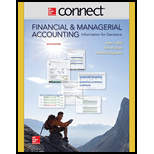
Concept explainers
Statement of
This statement records the activities related to inflows and outflows of cash and funds which take place in the company for a particular accounting period.
It has following three parts:
► Cash flow from operating activities
► Cash flow from investing activities
► Cash flow from financing activities
Cash Flow from Operating Activities:
The inflow and outflow of cash related to the operating nature is basically comes under operating activity. The cash flow from operating activities can be computed by some adjustment in the amount of net income.
There are two method of calculating cash flow from operating activity:
► One is the direct method, in this add revenue obtained and subtract the expenses.
► The other method of calculating cash flows from operating activity is an indirect method in this add non cash item to get correct cash flows.
Cash Flow from Investing Activities:
In this activity of cash flows, sale and purchase of investment/fixed assets, or any income related to the investment will be recorded.
For example a fixed asset acquire from the company that will reduce the cash flow and a sale of investment that will increase the cash flow from investing activity.
Cash Flow from Financing Activities:
This includes the cash flows related to financial transactions. The issue of shares will increase the cash flow from financing activity as it involves the increase in cash. The payment to the debenture holder involves
To identify: The type of cash flow activity.
Want to see the full answer?
Check out a sample textbook solution
Chapter 1 Solutions
Connect 2 Semester Access Card for Financial and Managerial Accounting
- Under absorption costing?arrow_forwardOffice Plus determines overhead rates based on machine hours. Budgeted overhead is $240,000, and budgeted machine hours are 20,000. If actual overhead is $250,000 and actual machine hours are 19,000, The overhead variance is favorable or unfavorable?arrow_forwardAnswer? ? Financial accounting questionarrow_forward
- In Barber Company, total material costs are $10,000 and total conversion costs are $20,000. Equivalent units of production are materials 1,000 and conversion costs 2,500. Unit costs for conversion costs is: a. $1. b. $8. c. $10. d. $18.arrow_forwardCost Account Questions.arrow_forwardQuestions - General Accountarrow_forward

 AccountingAccountingISBN:9781337272094Author:WARREN, Carl S., Reeve, James M., Duchac, Jonathan E.Publisher:Cengage Learning,
AccountingAccountingISBN:9781337272094Author:WARREN, Carl S., Reeve, James M., Duchac, Jonathan E.Publisher:Cengage Learning, Accounting Information SystemsAccountingISBN:9781337619202Author:Hall, James A.Publisher:Cengage Learning,
Accounting Information SystemsAccountingISBN:9781337619202Author:Hall, James A.Publisher:Cengage Learning, Horngren's Cost Accounting: A Managerial Emphasis...AccountingISBN:9780134475585Author:Srikant M. Datar, Madhav V. RajanPublisher:PEARSON
Horngren's Cost Accounting: A Managerial Emphasis...AccountingISBN:9780134475585Author:Srikant M. Datar, Madhav V. RajanPublisher:PEARSON Intermediate AccountingAccountingISBN:9781259722660Author:J. David Spiceland, Mark W. Nelson, Wayne M ThomasPublisher:McGraw-Hill Education
Intermediate AccountingAccountingISBN:9781259722660Author:J. David Spiceland, Mark W. Nelson, Wayne M ThomasPublisher:McGraw-Hill Education Financial and Managerial AccountingAccountingISBN:9781259726705Author:John J Wild, Ken W. Shaw, Barbara Chiappetta Fundamental Accounting PrinciplesPublisher:McGraw-Hill Education
Financial and Managerial AccountingAccountingISBN:9781259726705Author:John J Wild, Ken W. Shaw, Barbara Chiappetta Fundamental Accounting PrinciplesPublisher:McGraw-Hill Education





